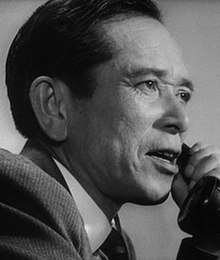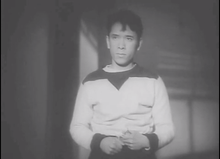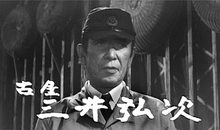Kōji Mitsui
Kōji Mitsui (三井弘次, Mitsui Kōji, 6 March 1910 – 20 April 1979) was a Japanese movie, TV, and stage actor. He appeared in more than 150 films from 1925 to 1975, including 29 of Kinema Junpo’s annual Top-10 winners and three of its Top-10 best Japanese films of all time.[1]
Kōji Mitsui | |
|---|---|
 Kōji Mitsui in The Bad Sleep Well | |
| Born | 6 March 1910 |
| Died | 20 April 1979 (aged 69) Kamakura, Japan |
| Other names | Hideo Mitsui (三井秀男) |
| Occupation | Actor |
| Years active | 1925–1978 |
Career

The son of a Shochiku movie theater owner, Mitsui joined the studio in 1924, making his film debut in 1925 under the name Hideo Mitsui (三井秀男).[2] His short stature, soft features, and expressive face and voice suited him for rebellious “younger brother” roles, and he appeared as a youth lead in many silent and early sound films, notably in several Yasujirō Ozu classics[3] and as a regular in the “Yota” film series.[2]
Mitsui eventually left Shochiku, returning in 1948 as Kōji Mitsui (三井弘次) and transitioning into character roles.[2] In 1954 he joined other Shochiku performers to create the Madoka Group, a film production company intended to bring stability to their profession.
Like many popular character actors of post-war Japan, Mitsui occasionally headlined minor films[4][5] but most often shone in key supporting parts. In 1957, Akira Kurosawa borrowed Mitsui from Shochiku to play the pivotal role of Yoshisaburo the gambler in The Lower Depths, whose final line in the film—annoyed that the suicide of one of the characters has ruined their party—is “always shocking, always devastating when viewed,” and Mitsui's delivery, which breaks the fourth wall, is “absolutely on target: ironic, cruel, funny, horrible.”[6] Kurosawa subsequently borrowed Mitsui (who had appeared in a small part in the director's 1950 Shochiku film Scandal) for five more of his Toho films.[6]
Mitsui often played drunken scenes, notably as a “one-scene wonder” in Kurosawa's Red Beard (1965). Life sometimes imitated art; confronted by director Kaneto Shindo over increasingly unusable takes during a drinking scene, Mitsui said, “What’s the difference between doing what you say and actually doing it?”[7] Notoriously, he was the actor (unnamed in Stuart Galbraith IV’s The Emperor and the Wolf[6]) who drunkenly called Kurosawa a “coward” at his home for not wanting to make any more movies following the failure of 1970's Dodes'ka-den (in which Mitsui had a cameo), after which the director tried to commit suicide—and a horrified Mitsui rushed to his side.[7]
In 1971, Mitsui underwent gastric ulcer surgery, further affecting a film career that had slowed by the late 1960s. He increasingly guest-starred on television programs, having appeared on more than 100 shows by the time he played his final role in 1978.[8] When he died in 1979, among the survivors was his younger brother Tadao Mitsui, a renowned anatomist who had studied as a Fulbright scholar at the University of Washington.[9]
Awards
In 1957 Mitsui won the Mainichi Film Award for Best Supporting Actor for The Lower Depths as well as his performances in two films directed by Minoru Shibuya, Kichigai buraku (The Unbalanced Wheel) and Seigiha (Righteousness).[2]
That year he also won the Blue Ribbon Award for Best Supporting Actor for The Lower Depths and Kichigai buraku.[2] With these two awards for The Lower Depths, Mitsui was able to distinguish himself among the top performers in Japanese cinema, whom Kurosawa had selected and dress-rehearsed on-set for 60 days to create the ultimate acting ensemble.[10]
Legacy

Mitsui's portrayal of the lazy nihilist in The Lower Depths is well-remembered as a showcase for his improvisational talents and his “strange and yet hypnotic,” “oboe-like,”[6] “beautiful voice with its unique charm and sense of rhythm.”[11] The film's final act becomes a tour de force for Mitsui, who mockingly impersonates Bokuzen Hidari (whose character's humanistic influence has been defeated by the gambler's cynicism), leads the remaining denizens in song, and ends the film with his brutal remark. According to frequent co-star Kyōko Kagawa, he was “fabulous” in the film and “great in any role.”[6]
Mitsui's largest part for Kurosawa after The Lower Depths was the lead journalist who comments on the wedding reception that opens The Bad Sleep Well (1960); his role as a sarcastic observer was noted by Kurosawa scholar Donald Richie to parallel traits of Yoshisaburo the gambler in the prior film,[12] and Mitsui's “particularly enthralling”[13] performance helped to associate his legacy with sardonic characters as well as boozy ones.
Mitsui was a voice actor in Japan's first sound cartoon, Chikara to Onna no Yo no Naka (1933; now lost), and appeared in Japan's first color film, Carmen Comes Home (1951). A star of Ozu's 1934 original silent version of A Story of Floating Weeds, he was stunt-cast in the director's own widely acclaimed 1959 color remake, Floating Weeds, which Roger Ebert named as one of the ten greatest films of all time.[14]
In media coverage of the 2017-2018 TV Tokyo reality series “The Supporting Actors,” which featured six popular character actors living together, the stars repeatedly cited Kōji Mitsui as a major influence and an example of a distinctive and superlative member of their profession.[15][16]
At a 2017 event, the actor Tatsuya Nakadai stated that during the filming of Kurosawa's 1963 High and Low, he felt added pressure having to deliver a 10-minute monologue because Mitsui was in the scene.[17] The two also appeared onscreen together in Kobayashi’s The Human Condition (1959) and The Inheritance (1962), as well as Okamoto’s Battle of Okinawa (1971); in 1975, Nakadai appeared in a stage production of Gorky’s The Lower Depths as the gambler character who was closely associated in Japan with Mitsui’s portrayal in Kurosawa’s 1957 film version.
In addition to his many performances for prominent directors such as Kurosawa, Ozu, Kobayashi, and Kinoshita, Mitsui is best known to Western audiences as the duplicitous village elder in Hiroshi Teshigahara's Oscar-nominated[18] Woman in the Dunes (1964), for which he received above-the-title billing on the original film poster along with stars Eiji Okada and Kyōko Kishida.[19]
Partial Filmography
| Year | Title | Director | Role | Notes |
|---|---|---|---|---|
| 1933 | Chikara to Onna no Yo no Naka | Kenzō Masaoka | Voice | First Japanese sound cartoon (lost); as Hideo Mitsui |
| Dragnet Girl | Yasujirō Ozu | Hiroshi | Silent; as Hideo Mitsui | |
| 1934 | A Story of Floating Weeds | Yasujirō Ozu | Shinkichi | Silent; as Hideo Mitsui |
| A Mother Should be Loved | Yasujirō Ozu | Kosaku | Silent; as Hideo Mitsui | |
| 1940 | Urban Torrent | Kôjirô Sasaki | Kirō | as Hideo Mitsui |
| 1946 | The Elegant Vagabond | Masahiro Makino | Gentarō | as Hideo Mitsui |
| 1950 | The Bells of Nagasaki | Hideo Ōba | Yamashita | |
| 1951 | Carmen Comes Home | Keisuke Kinoshita | Oka | First Japanese color film |
| 1956 | I Will Buy You | Masaki Kobayashi | Tamekichi Kurita | |
| Early Spring | Yasujirō Ozu | Hirayama | ||
| 1957 | The Lower Depths | Akira Kurosawa | Yoshisaburo (the gambler) | Mainichi, Blue Ribbon awards (best supporting actor) |
| Times of Joy and Sorrow | Keisuke Kinoshita | Mr. Kanemaki | ||
| 1958 | The Hidden Fortress | Akira Kurosawa | Pit guard | Cameo appearance |
| 1959 | Floating Weeds | Yasujirō Ozu | Kichinosuke | Mitsui played the youth lead in the 1934 original |
| The Human Condition | Masaki Kobayashi | Furuya | First film in trilogy | |
| 1960 | The Bad Sleep Well | Akira Kurosawa | Lead journalist | |
| 1961 | My Face Red in the Sunset/Killers on Parade | Masahiro Shinoda | Knife assassin | |
| 1962 | Gang vs. Gang | Teruo Ishii | Yanagisawa | |
| 1963 | High and Low | Akira Kurosawa | Journalist | Cameo appearance |
| 1964 | Woman in the Dunes | Hiroshi Teshigahara | Village elder | |
| 1965 | A Fugitive from the Past | Tomu Uchida | Motojima | |
| Red Beard | Akira Kurosawa | Heikichi | ||
| 1967 | Japan's Longest Day | Kihachi Okamoto | Weeping reporter | Cameo appearance |
| 1975 | The Great Jailbreak | Teruo Ishii | Ryota | Final film role |
References
- "Japanese Movies All Time Best 200 (Kinejun Readers)". MUBI. mubi.com. Retrieved 17 March 2019.
- "Mitsui Kōji". Kotobanku (in Japanese). Asahi Shinbun. Retrieved 17 February 2015.
- "Mitsui Kōji". allcinema (in Japanese). allcinema. Retrieved 2 January 2018.
- "It's Sunny Tonight". Movie Walker (in Japanese). movie.walkerplus.com. Retrieved 10 March 2019.
- "I'll Scratch Your Back". Movie Walker (in Japanese). movie.walkerplus.com. Retrieved 28 March 2019.
- Galbraith IV, Stuart (2002). The Emperor and the Wolf – The Lives and Films of Akira Kurosawa and Toshiro Mifune. Faber. pp. 240–241, 488. ISBN 0-571-19982-8.
- "The One and Only Voice". Hatena Blog (in Japanese). hatenablog.com. Retrieved 8 March 2019.
- "Mitsui Kōji". TV Drama Database (in Japanese). tvdrama-db.com. Retrieved 12 March 2019.
- "Professor Emeritus Dr. Tadao Mitsui". J-STAGE. Japan Science and Technology Agency. Retrieved 12 September 2019.
- "Donzoko (The Lower Depths)". Senses of Cinema. sensesofcinema.com. Retrieved 18 March 2019.
- "Donzoku". Samedasu (in Japanese). Dream.jp. Retrieved 5 January 2018.
- Richie, Donald (1998). The Films of Akira Kurosawa. University of California Press. p. 126. ISBN 0520220374.
- Wild, Peter (2014). Akira Kurosawa, Critical Lives. Reaktion Books. p. 119. ISBN 1780233809.
- Ebert, Roger (April 1, 1991). "Ten Greatest Films of All Time". Roger Ebert. Retrieved February 13, 2017.
- "Entertainment Idol". Smart Flash (in Japanese). smart-flash.jp. Retrieved 15 March 2019.
- "Tomorowo Taguchi: 'The Supporting Players' To Feature 'The Scene of the Chaos'". Sponichi Annex (in Japanese). sponichi.co.jp. Retrieved 15 March 2019.
- "Tatsuya Nakadai: 'Director Akira Kurosawa had a relentless attention to visuals'". Logmi (in Japanese). logmi.co.jp. Retrieved 29 April 2020.
- "The 37th Academy Awards (1965) Nominees and Winners". oscars.org. Retrieved 2011-11-05.
- "Woman in the Dunes (1964)". IMDb. imdb.com. Retrieved 11 March 2019.
External links
- Kōji Mitsui on IMDb